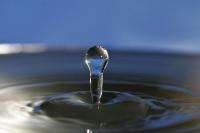January 21, 2010 feature
Water still has a few secrets to tell

(PhysOrg.com) -- We are used to thinking of water as a substance with relatively few secrets left. Its basic structure has been studied by high school students for decades, and water is considered essential to our survival, as it is so abundant. We tend to think that we've got water pretty well figured out, and what we know about it is of vital importance to life on Earth. But, as a team at Chalmers University of Technology in Göteborg, Sweden, recently found, water isn’t as straightforward as we might think.
“Due to long range interactions, you can obtain a ‘solid like’ behavior in certain types of measurements for liquids,” Jan Swenson, one of the scientists on the project, tells PhysOrg.com. “These hidden slow dynamics has been suspected, but because they are impossible to observe straight on in dielectric measurements, they have been difficult to find. We are quite happy that we have come up with a method that can help us probe a little more deeply into the dynamical behavior of water and other liquids.” Swenson, and his colleagues, Helén Jansson and Rikard Bergman, have started to use a method demonstrating for the first time that water can exhibit a very slow relaxation process. Their results can be seen in Physical Review Letters: "Hidden Slow Dynamics in Water."
“It all started when we were studying protein solutions,” Swenson explains. “We used Teflon films to reduce conductivity and electrode polarization, and then measured the solvents and the proteins. We saw low frequency dynamics in the solvent, and saw that it was not due to the protein.” Swenson and his peers decided to see if it was perhaps due to the Teflon, but then saw it wasn’t, although the Teflon film plays an important role in identifying water’s hidden dynamics, due to its suppression of electrode polarization and conductivity. “Without a different way of analyzing this and using the Teflon film, it was practically impossible to see these dynamics.”
For the most part, though, slow dynamics have a rather small effect. “This is a very weak feature,” Swenson concedes. “It does not dramatically change the behavior of liquids, but it is an interesting feature that could be of importance. Understanding it could be useful, at least in better understanding the structure and behavior of liquids.”
Swenson thinks that these dynamics might apply to all hydrogen bonded liquids. “So far, it appears that this might be universal. We have been looking at different liquids, and have seen something similar. However, we have only tried it with hydrogen bonded liquids.” The next step, then, is to analyze liquids without hydrogen bonds. “We want to see if it has something to do with the hydrogen bonds. Are these dynamics related to the strength of the hydrogen bonds on the short range scale? We want to test as many liquids as we can to see the results.”
In the end, it appears that there is more that we can learn from studying water, and its dynamics. “We always have a lot to learn, and it could prove helpful for our understanding,” Swenson says.
More information: Helén Jansson, Rikard Bergman, and Jan Swenson, “Hidden Slow Dynamics in Water,” Physical Review Letters (2010). Available online: link.aps.org/doi/10.1103/PhysRevLett.104.017802
Copyright 2010 PhysOrg.com.
All rights reserved. This material may not be published, broadcast, rewritten or redistributed in whole or part without the express written permission of PhysOrg.com.
















